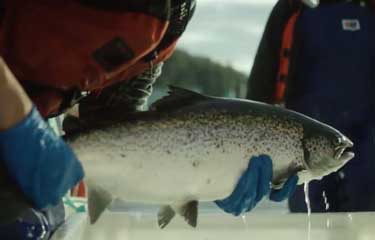A joint venture between Japanese seafood firms Mitsubishi and Maruha Nichiro will branch into land-based salmon farming, with its first project planned to begin construction soon in Nyuzen, Toyama, Japan.
Both based in Tokyo, Japan, Mitsubishi and Maruha Nichiro are two of the largest seafood companies in the world. Mitsubishi owns Norwegian salmon farmer Cermaq and U.K. food and distribution group Princes, and had total sales of JPY 863 billion (USD 6.4 billion, EUR 6.1 billion) while Maruha Nichiro recorded JPY 900 billion (USD 6.6 billion, EUR 6.4 billion) in sales of fishery and aquaculture products for its fiscal year ending March 2022.
The Atland Corporation will be 51 percent owned by Mitsubishi and 49 percent owned by Maruha Nichiro. The companies said in a joint press statement they have been discussing the idea of collectively branching into land-based salmon farming – and specifically the development of a land-based salmon farm in Nyuzen, Japan – since March 2021. The project cost of the project is JPY 11 billion (USD 81.4 million, EUR 78.5 million).
“This project is expected to help develop a sustainable and stable land-based production system, efficient digital-tech-based operations, local production for local consumption, and progress in decarbonization,” they said. “Our companies are both dedicated to leveraging our strengths and businesses to simultaneously generate economic, environmental, and societal value.”
Pending approval from local and national regulatory authorities, the two companies hope to begin operations at the new farm in 2025 and complete its first delivery by 2027. The recirculation aquaculture system (RAS) farm will have an annual production capacity of 2,500 metric tons of live-weight salmon, they said.
“There are few suitable locations for conventional salmon aquaculture, due to the need for year-round low seawater temperatures, mild weather, and wave activity. For those reasons, the vast majority of the world’s farmed salmon is produced in Norway and Chile, but expectations are that global demand for this high-quality animal protein will continue to grow in the future,” they said. “The aim of our joint project is to create a local-production-for-local-consumption business model in Japan’s salmon industry.”
Operating a local salmon farm in Japan, with the target of feeding domestic consumers, “is expected to produce fewer greenhouse gas emissions compared to the practice of importing fresh salmon to Japan by air from salmon-farming countries,” they companies said.
The farm will use a combination of water from the Kurobe River and deep seawater from the Toyama bay. The sea-water conditions in Toyama prefecture, where the farm will be built, is ideal for RAS-salmon farming, with low temperature, high salinity, and low dissolved oxygen, the firms said.
The companies also hope to integrate state-of-the-art technology, including artificial intelligence and Internet of Things technology, into the operations system of Atland’s new farm.
“Land-based aquaculture that uses RAS is highly compatible with digital technologies. These systems use advanced water-treatment technologies to control and manage the farming environment. By employing these methods, we aim to take advantage of AI and IoT to stabilize production, and otherwise optimize our own salmon farming operations,” they said.
There are several other RAS salmon projects underway in Japan, with two already in operation – Kotoura Grand Salmon and the Mitsui-owned FRD Japan. Pure Salmon, owned by private equity fund 8F Asset Management in Singapore, is building a 10,000-ton-per-annum Japanese facility in Tsu City, Mie prefecture utilizing RAS technology from AquaMaof Aquaculture Technologies. And Proximar Seafood is planning an RAS facility with an annual production capacity of 5,300 MT in Shizuoka prefecture. The company recently scored a distribution contract with Marubeni.
In Maruha Nichiro’s 2020 annual report, the company’s president and CEO, Masaru Ikemi, hinted his firm was looking to branch into new ways of delivering salmon to its customers.
“I would like us to transcend the confines of marine and food products to create new value chains. The plan calls on us to process and deliver to markets the seafood products we procure, without clinging to the past,” he wrote. “There are many external factors serving as reason to do so, including direct delivery from production areas to consumers and the decreasing volume of fish consumption by the Japanese.”
Ikemi also insinuated his company will key in on health-focused messaging in selling the salmon it produces.
“We pay close attention to what consumers want, develop products to match those needs, and tenaciously sell those products. It may seem simple at first glance, but I believe the ability of an organization to directly approach this challenging mission and to somehow overcome the barriers is what gives a company the ability to adapt to a changing environment,” he wrote. “In addition to catching and raising fish, our accomplishments include putting onto the market products that contribute to people’s health by enabling them to take in quality protein … We are a company whose business started out in the ocean, and we have reached this point now by learning from the ocean and utilizing its bounty. I want us to remember to work in sync with our brand strategy so that we can deliver a powerful message promoting fish as food products that contribute to people’s health, inform consumers about our company and our approach, and encourage them to pick up Maruha Nichiro products because they are good for health.”
Photo courtesy of Mitsubishi







